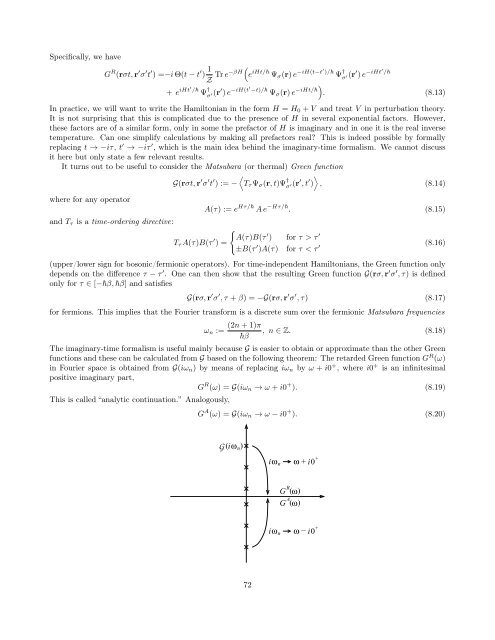Carsten Timm: Theory of superconductivity
Carsten Timm: Theory of superconductivity
Carsten Timm: Theory of superconductivity
Create successful ePaper yourself
Turn your PDF publications into a flip-book with our unique Google optimized e-Paper software.
Specifically, we have<br />
G R (rσt, r ′ σ ′ t ′ ) =−i Θ(t − t ′ ) 1 Z Tr e−βH( e iHt/ Ψ σ (r) e −iH(t−t′ )/ Ψ † σ ′(r′ ) e −iHt′ /<br />
+ e iHt′ / Ψ † σ ′(r′ ) e −iH(t′ −t)/ Ψ σ (r) e −iHt/) . (8.13)<br />
In practice, we will want to write the Hamiltonian in the form H = H 0 + V and treat V in perturbation theory.<br />
It is not surprising that this is complicated due to the presence <strong>of</strong> H in several exponential factors. However,<br />
these factors are <strong>of</strong> a similar form, only in some the prefactor <strong>of</strong> H is imaginary and in one it is the real inverse<br />
temperature. Can one simplify calculations by making all prefactors real? This is indeed possible by formally<br />
replacing t → −iτ, t ′ → −iτ ′ , which is the main idea behind the imaginary-time formalism. We cannot discuss<br />
it here but only state a few relevant results.<br />
It turns out to be useful to consider the Matsubara (or thermal) Green function<br />
⟨<br />
⟩<br />
G(rσt, r ′ σ ′ t ′ ) := − T τ Ψ σ (r, t)Ψ † σ ′(r′ , t ′ ) , (8.14)<br />
where for any operator<br />
and T τ is a time-ordering directive:<br />
T τ A(τ)B(τ ′ ) =<br />
A(τ) := e Hτ/ A e −Hτ/ . (8.15)<br />
{<br />
A(τ)B(τ ′ ) for τ > τ ′<br />
±B(τ ′ )A(τ) for τ < τ ′ (8.16)<br />
(upper/lower sign for bosonic/fermionic operators). For time-independent Hamiltonians, the Green function only<br />
depends on the difference τ − τ ′ . One can then show that the resulting Green function G(rσ, r ′ σ ′ , τ) is defined<br />
only for τ ∈ [−β, β] and satisfies<br />
G(rσ, r ′ σ ′ , τ + β) = −G(rσ, r ′ σ ′ , τ) (8.17)<br />
for fermions. This implies that the Fourier transform is a discrete sum over the fermionic Matsubara frequencies<br />
ω n :=<br />
(2n + 1)π<br />
, n ∈ Z. (8.18)<br />
β<br />
The imaginary-time formalism is useful mainly because G is easier to obtain or approximate than the other Green<br />
functions and these can be calculated from G based on the following theorem: The retarded Green function G R (ω)<br />
in Fourier space is obtained from G(iω n ) by means <strong>of</strong> replacing iω n by ω + i0 + , where i0 + is an infinitesimal<br />
positive imaginary part,<br />
G R (ω) = G(iω n → ω + i0 + ). (8.19)<br />
This is called “analytic continuation.” Analogously,<br />
G A (ω) = G(iω n → ω − i0 + ). (8.20)<br />
G ( iω n )<br />
ω n<br />
i ω + i0 +<br />
R<br />
G (ω)<br />
A<br />
G (ω)<br />
i ω − i0 +<br />
ω n<br />
72

















